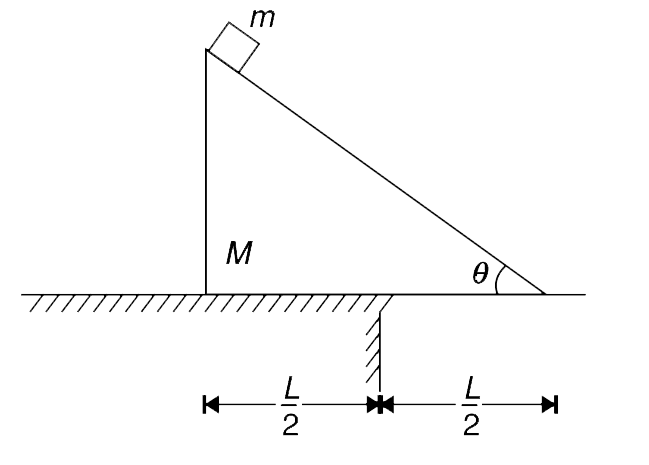Figure shows an irregular wedge of mass m placed on a smooth horizontal surface. Part BC is rough.
What minimum velocity should be imparted to a small block of same mass m so that it may each point B :

2√gH
√2gH
2√g(H−h)
√gh
The correct Answer is:A
Let 'u' be the required minimum velocity . By momentum conservation :
mu=(m+m)v⇒v=u/2

Energy equation :
12mu2=12(2m)v2+mgH
Substituting v=u/2:
u=2√gH
Similar Questions
A block of mass m is placed at rest on a smooth wedge of mass M placed at rest on a smooth horizontal surface. As the system is released

View SolutionA triangular wedge of mass M lies on a smooth horizontal table with half of its base projecting out of the edge of the table. A block of mass m is kept at the top of the smooth incline surface of the wedge and the system is let go. Find the maximum value of Mm for which the block will land on the table. Take θ=60∘.

View Solution
Knowledge Check
Figure shows an irregular wedge of mass m placed on a smooth horizontal surface. Part BC is rough.
The magnitude of velocity of wedge when the block comes to rest (w.r.t. wedge ) on part BC is :A√gHB√g(H−h)C2√gHDnone of theseFigure shows an irregular wedge of mass m placed on a smooth horizontal surface. Part BC is rough.
If the coefficient of friction between the block and wedge is μ, and the block comes to rest with respect to wedge at a point E on the rough surface then BE will beAHμBH−hμChμDnone of theseFor the system shown in the figure, a small block of mass m and smooth irregular shaped block of mass M, both free to move are placed on a smooth horizontal plane. The minimum velocity v imparted to block so that it will overcome the highest point of M is
 A√2ghB√2(1+mM)ghC√2mMghD√2(1+Mm)gh
A√2ghB√2(1+mM)ghC√2mMghD√2(1+Mm)gh
A block of mass m is placed on the rough incline of a wedge of mass M and inclination α to the horizontal. Calculate the maximum and minimum acceleration that can be imparted to the wedge so that the block may remain stationary relative to the wedge. The coefficient iof friction between the block and the wedge is μ.
View SolutionA smooth wedge of mass M rests on a smooth horizontal surface. A block of mass m is projected from its lowermost point with velocity v0. What is the maximum height reached by the block?

View SolutionTwo blocks A and B of masses m and 2m are placed on a smooth horizontal surface. Block B is given a speed of 3m/s. Find
(i) The maximum speed of A
(ii) The minimum speed of B.

View SolutionA block of mass m is placed on a rough horizontal surface. If minimum force to pull the block is mg2 then coefficient of friction is :
View SolutionThe figure shows a block of mass M=2m having a spherical smooth cavity of radius R placed on a smooth horizontal surface .There is a small ball of mass m moving at an instant vertically downward with a velocity v with respect to the block .At this instant :

View Solution

